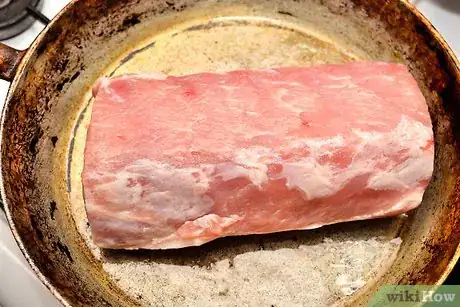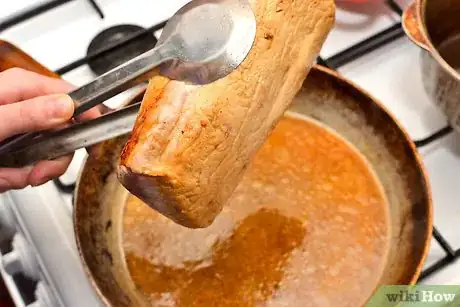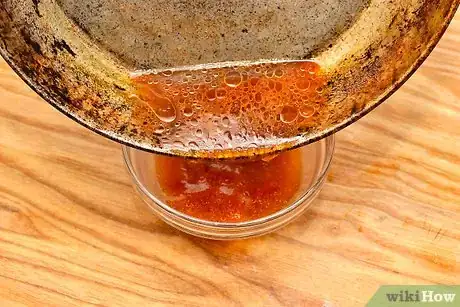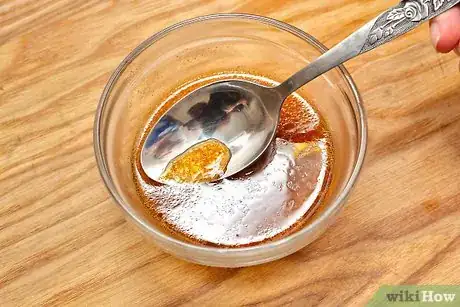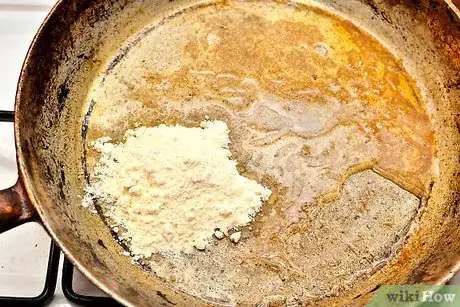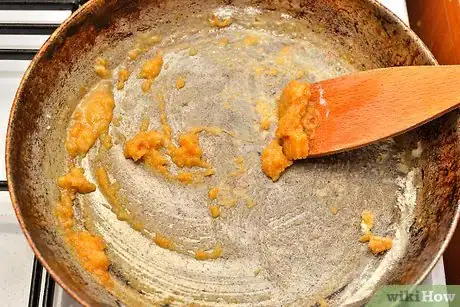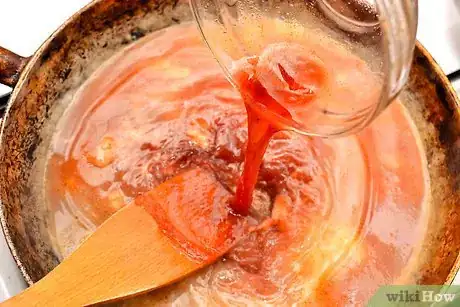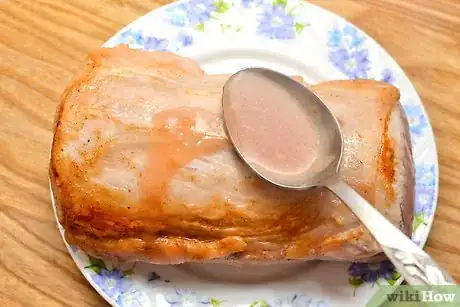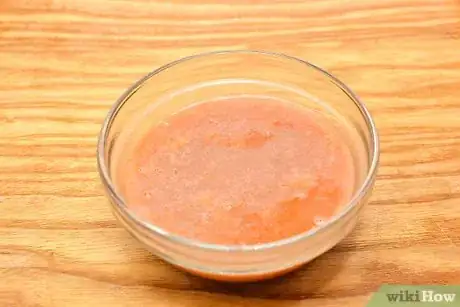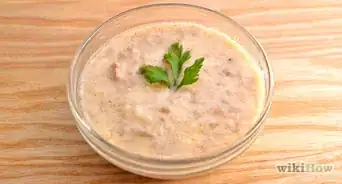This article was co-authored by wikiHow Staff. Our trained team of editors and researchers validate articles for accuracy and comprehensiveness. wikiHow's Content Management Team carefully monitors the work from our editorial staff to ensure that each article is backed by trusted research and meets our high quality standards.
This article has been viewed 450,548 times.
Learn more...
Pork gravy is salty, delicious, and a welcome addition to any pork meal. Follow these simple steps to make tasty pork gravy that will leave your family smiling and your friends begging for the recipe.
Steps
Collecting the Juices
-
1Know that pork gravy is made from the drippings of cooked pork. In order to collect the drippings to make the gravy, you need to cook the pork first. This can be done in one of two ways.
- Roast the pork: Select your cut of pork and place it in an oven-proof dish or pan fat-side down. Preheat the oven to 400°F (204°C). When the oven has heated, place the roasting dish and pork into the oven. Roast the pork for 30 minutes and then flip it so the pork is fat-side up. Rotating the pork allows the whole pork cut to roast thoroughly. Remove the pork and let it stand for 10 minutes.
- Sautee pork chops: Season your pork chops with salt and pepper on both sides. Heat butter in a large skillet or pan on medium-high heat. If you prefer, you can use olive oil instead of butter. Place the pork chops in the skillet and cook them until they are brown on both sides and cooked all the way through. This should take three to five minutes. The pork is done when the meat is white on the inside.[1]
-
2Collect the juices from the cooked pork. When you pick the meat up from the pan or skillet, hold the meat over the pan for a few second. Doing this allows the extra juices to drip off the meat and into the pan.Advertisement
-
3Pour the juices from the pan or skillet into a glass measure. The glass measure allows you to see when the fat separates from the juices. Let the drippings stand in the container until the fat floats to the top.
- If you do not have a glass measure, you can use a small cooking pot.
-
4Skim the fat from the top once it has separated from the juices. Put the fat in its own small stove top pan. You will need roughly three tablespoons of the fat for the gravy.
Making the Gravy
-
1Put the fat back on the stove. You should have three tablespoons of fat. Place the pan with the fat back on the stove. Add three tablespoons of flour to the fat and stir.
-
2Cook the flour and fat over medium heat. You should cook the mixture for one to two minutes, stirring constantly. Make sure to scrape any browned bits free from the bottom and sides of the pan.
-
3Add ingredients to your drippings. You will want to have 2 cups of dripping mixture. Measure how much drippings you have and then pour the drippings into a mixing bowl. Add the liquids of your choice so that you have two cups of drippings.
- Add pork broth or stock to your drippings for a truly salty, pork flavor.
- Add sherry or red for a more gourmet gravy. Gravies benefit from a bit of acidity. Wines or sherries add a depth of flavor to the gravy that comes from the addition of the acidity.
- Some people enjoy making gravy by mixing the drippings with a can of cream of mushroom soup.[2]
-
4Add the drippings mixture to the flour and fat mixture. Stir both mixtures in the pan over medium heat. The gravy should become smooth and thick. Add salt and pepper to taste.
- If it is not thick enough for your taste, add another tablespoon of flour.
-
5Pour your gravy over your pork and any other side dishes you may have cooked. Enjoy!
-
6Finished.
Community Q&A
-
QuestionHow do I make dark pork gravy?
 Community AnswerReduce heat to low; cover and cook for 45-60 minutes or until pork is tender, basting occasionally with pan juices. Remove roast to a serving platter; keep warm. Pour drippings and loosened browned bits into a 2-cup measuring cup; skim fat. Add enough water to measure 1-1/2 cups.
Community AnswerReduce heat to low; cover and cook for 45-60 minutes or until pork is tender, basting occasionally with pan juices. Remove roast to a serving platter; keep warm. Pour drippings and loosened browned bits into a 2-cup measuring cup; skim fat. Add enough water to measure 1-1/2 cups. -
QuestionI made a pork loin with a bed of vegetables and chicken broth. What do I do with the broth?
 Community AnswerPut the chicken and vegetables in a bowl with the broth and make a soup!
Community AnswerPut the chicken and vegetables in a bowl with the broth and make a soup! -
QuestionCan I freeze the gravy for later use?
 Community AnswerYes, you can! Freeze it in a plastic Tupperware container. You can reheat it in the microwave or on the stove in a saucepan.
Community AnswerYes, you can! Freeze it in a plastic Tupperware container. You can reheat it in the microwave or on the stove in a saucepan.
Things You'll Need
- Pork drippings and the pan the pork was cooked in
- All purpose flour
- Flavorful liquid (chicken stock, pork broth, vegetable stock, potato water, wine, cream of mushroom soup)
- Whisk or other stirring utensil
- Salt and pepper
References
About This Article
To make pork gravy, roast or sauté a cut of pork and save the juices that collect in the cooking pan. Pour the juices into a glass bowl or measuring cup and allow them to stand until the fat floats to the top. Then, use a spoon to skim away the fat. Place about 3 tablespoons (44 mL) of the fat in a small stovetop pan. Mix 3 tablespoons (23 g) of all-purpose flour in with the fat and cook the mixture for 1 to 2 minutes over medium heat, stirring constantly. Turn off the heat and set the fat mixture aside. Pour some of the pork juices into a measuring cup and top it off with any other ingredients of your choice so that you have about 2 cups of liquid. Try combining the drippings with pork stock, cooking sherry, or cream of mushroom soup. Add the mixture to the flour and fat mixture in the pan and stir them together over medium heat until the gravy is thick and smooth. Add a little salt and pepper to taste. Serve your gravy hot over the pork you just cooked or add it to any other dish of your choice. For more tips, including how to thicken your gravy if you don't like the consistency, read on!
